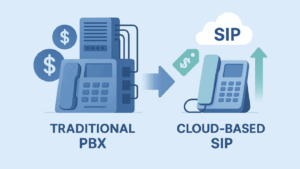
The Definitive Guide to Hosted PBX vs. SIP Trunking Differences
In business communications, navigating through options like Hosted PBX and SIP Trunking can get tangled up pretty quickly. Here’s the quick answer you’re looking for: The main difference is that Hosted PBX is a cloud-based phone system managed by a third-party provider, requiring no on-premise hardware. SIP Trunking, on the other hand, connects your existing on-premise PBX to the internet, bringing VoIP capabilities to your current setup.
- Hosted PBX: Cloud-based, no need for on-premise equipment, easier to scale, managed by a third-party.
- SIP Trunking: Requires on-premise PBX, integrates with existing systems, ideal for businesses with in-house IT.
Modern businesses are moving towards flexible, scalable solutions for their communication needs. Both Hosted PBX and SIP Trunking offer paths towards modernizing your communication systems, but they cater to different needs and capabilities. Hosted PBX is about offloading the complexity to a provider, making it a plug-and-play experience with minimal fuss. Conversely, SIP Trunking is for those who have invested in on-premise PBX systems and have the IT backbone to manage the integration, offering a bridge between traditional systems and modern VoIP functionalities.
For small to medium-sized businesses craving modernization without heavy investment in infrastructure or in-house expertise, understanding the nuances of these options is crucial. Whether your pain points revolve around outdated systems, a desire for improved flexibility, or a watchful eye on costs, the journey towards a decision begins with a clear grasp of the fundamentals.
As you consider your business’s path forward, the right choice balances your current assets and capabilities with your aspirations for growth and adaptability. The goal is a solution that supports not just where your business stands today but where it’s headed tomorrow.

For further exploration into these options and how they align with your business needs, consider visiting resources like VoIP-info, TechTarget, or PCMag for in-depth guides and comparisons.
Understanding Hosted PBX
When we talk about Hosted PBX, we’re diving into a world where your phone system lives in the cloud, not in a closet at your office. It’s like having a virtual assistant who manages all your calls without needing a physical space at your place. Pretty neat, right?
Cloud-based
Imagine all your phone system’s brains and brawn sitting comfortably in the cloud. This means you can access it from anywhere with an internet connection. It’s not just convenient; it’s a game-changer for businesses that are spread out or have team members working remotely.
Third-party Management
With Hosted PBX, a service provider takes care of all the heavy lifting. They manage the technology, the updates, and any gremlins that might pop up. This is great because it means you don’t have to be a tech wizard to have a sophisticated phone system. You can focus on your business, and let the experts handle the rest.
Broadband Connection
All you need to connect to your Hosted PBX is a solid internet connection. This is crucial because the quality of your calls depends on it. Think of it as the highway your voice travels on. The better the highway (internet connection), the smoother the ride (call quality).
Poly, Yealink Phones
When it comes to choosing phones for your Hosted PBX system, brands like Poly and Yealink are top-notch. These phones are designed to work seamlessly with VoIP technology. They’re like the cool gadgets that make your communication crystal clear and reliable.

The beauty of Hosted PBX is its simplicity and flexibility. Whether you’re a small business just starting or a growing enterprise with teams around the globe, this solution scales with you. And with the backing of reliable brands and a strong broadband connection, you’re set for success.
For those interested in the technical side or looking for more detailed comparisons, sites like Techopedia and Network World offer great insights into how Hosted PBX works and its benefits for businesses of all sizes.
In the next section, we’ll dive into SIP Trunking and how it compares to Hosted PBX, so you can make an informed decision about what’s best for your business needs.
Continue to Exploring SIP Trunking →
Exploring SIP Trunking
SIP Trunking is like giving your traditional phone system a passport to the online world. It allows your existing on-premise PBX (Private Branch Exchange) to connect to the internet, enabling you to make calls over the web instead of using traditional phone lines. This is especially useful if you’re using systems like Microsoft Teams or Zoom Phone, as SIP Trunking seamlessly integrates with these platforms, enhancing your communication capabilities.
On-premise PBX is essentially the heart of SIP Trunking. It’s the physical hardware system that exists within your business premises, managing your internal and external calls. Think of it as the command center for all your communication needs. However, to step into the modern age of internet calls, this system needs a bridge – and that’s where SIP Trunking comes in.
Internet connectivity plays a crucial role in SIP Trunking. Since calls are made over the internet, having a stable and fast connection is paramount. This ensures that your calls are clear, without any lag or interruptions. It’s like the difference between having a smooth, paved road and a bumpy, dirt path. The smoother the road (or in this case, the internet connection), the smoother your journey (or call) will be.
For those using modern communication platforms like Microsoft Teams or Zoom Phone, SIP Trunking acts as a powerful enhancer. It allows these platforms to connect with traditional phone systems, providing a bridge between the old and the new. This means you can enjoy the advanced features of these platforms while still making use of your existing phone system.
IP-PBX is the next evolution of the traditional PBX system. It’s designed to handle Voice over Internet Protocol (VoIP) calls directly, making it inherently compatible with SIP Trunking. If you’re starting from scratch or looking to upgrade, an IP-PBX system might be the way to go, as it’s built for the internet age.
Lastly, analog adapters (or ATAs) play a crucial role in the SIP Trunking setup. These devices allow you to connect traditional analog phones to your IP network. It’s like having an adapter that lets you plug a vintage record player into a modern sound system. This way, you can keep using your existing phones while benefiting from the features and cost savings of VoIP calls.
In summary, SIP Trunking offers a way to modernize your business communications without completely abandoning your existing infrastructure. Whether you’re using an on-premise PBX, Microsoft Teams, Zoom Phone, or even old analog phones, SIP Trunking provides the flexibility and scalability needed in today’s business environment. With the right internet connectivity and equipment, you can enjoy improved call quality, reduced costs, and a seamless integration of old and new technologies.
Continue to Key Differences Between Hosted PBX and SIP Trunking →
Key Differences Between Hosted PBX and SIP Trunking
When diving into business communication systems, understanding the difference between hosted PBX and SIP trunking is crucial. Let’s break it down into simple terms, focusing on the key aspects that set them apart.
Hardware and Initial Setup Costs
Hosted PBX is like renting a fully furnished office; you get everything you need without the upfront investment. Your provider hosts the PBX system in the cloud, meaning you save big on initial hardware and setup costs. All you need are IP phones and a stable internet connection. Think of it as Cloud PBX savings, where the heavy lifting is done off-site.
SIP Trunking, on the other hand, is akin to setting up your own office from scratch. If you’re starting without an existing PBX, the upfront costs can be significant. You’ll need an on-premise PBX, SIP trunks, and possibly new IP phones or adapters for your old phones. However, if you already have a compatible PBX, SIP trunking enhances what you’ve got without the need for a complete overhaul.
Maintenance and Ongoing Costs
With hosted PBX, think of having a landlord who handles all the maintenance. The provider is responsible for keeping the system up-to-date and running smoothly. This means less worry for you and potentially lower ongoing costs, as you typically pay a predictable monthly subscription fee.
SIP Trunking requires you to be the handyman. Your in-house IT staff manages the system, which includes updates and maintenance. While this might mean more control, it also means higher ongoing costs related to staffing and potential system upgrades.
Scalability and Flexibility
Hosted PBX shines in scalability and flexibility. Adding users or expanding to new locations? It’s as simple as a few clicks in the Admin Portal. This system grows with your business, offering unlimited space and user addition without the need for physical infrastructure changes.
SIP Trunking also offers scalability but in a different way. It allows for unlimited connectivity as long as your on-premise PBX can handle it. However, scaling up might involve more technical adjustments and potential licensing costs.
Call Quality and Security
Both systems rely heavily on internet connectivity. Quality and security can vary based on your setup and provider. Hosted PBX and SIP Trunking can offer high call quality and robust security measures, including end-to-end encryption. However, the responsibility for security in SIP Trunking falls more heavily on your shoulders, requiring a solid understanding of networking and security protocols.
Geographical Flexibility and Software Interface
Hosted PBX offers unparalleled geographical flexibility. Your team can access the phone system from anywhere—be it home, a café, or halfway across the world—using webphones and mobile apps. This is a game-changer for businesses with remote teams or frequent travelers.
SIP Trunking also supports remote work, but it might require more setup and configuration to ensure smooth access for your team. The software interface for managing SIP Trunking can be more complex, often requiring more technical expertise.
In conclusion, the choice between hosted PBX and SIP Trunking boils down to your business’s specific needs, technical capabilities, and growth plans. Both have their advantages, but understanding these key differences will help you make an informed decision that aligns with your communication strategy.
Continue to Frequently Asked Questions about Hosted PBX and SIP Trunking →
Frequently Asked Questions about Hosted PBX and SIP Trunking
Navigating business communication can be tricky. Let’s simplify it with answers to some of the most common questions about the difference between hosted PBX and SIP Trunking.
What is the main difference between Hosted PBX and SIP Trunking?
The biggest difference lies in where and how the systems operate.
-
Hosted PBX is like renting an apartment. You use the space (phone system) and amenities (features and functionalities), but someone else (the provider) owns, maintains, and updates it. It’s cloud-based, meaning it’s managed off-site by a third-party provider. You don’t need to buy or maintain the hardware.
-
SIP Trunking, on the other hand, is like owning a home. You have your own on-premise PBX equipment that you buy, control, and maintain. SIP Trunking connects this existing system to the internet, allowing you to use VoIP services and features.
Can SIP Trunking work with any PBX system?
Mostly, yes. Modern PBX systems are generally SIP-enabled, meaning they can work with SIP Trunking right out of the box. For older systems, an analog telephone adapter (ATA) can be used to bridge the gap, allowing these systems to connect to SIP trunks. However, it’s crucial to check compatibility with your provider to ensure smooth operation. More about PBX compatibility with SIP Trunking.
How does internet quality affect Hosted PBX and SIP Trunking?
Internet quality is the backbone of both Hosted PBX and SIP Trunking. Since both systems rely on internet connectivity to function, the quality of your internet connection directly impacts call quality, reliability, and overall user experience.
-
For Hosted PBX, a stable and fast internet connection is vital as all your calls and data are routed through the cloud. Poor internet can lead to dropped calls, latency, and other quality issues.
-
SIP Trunking also requires a good internet connection, especially if you have a high volume of calls. However, since the PBX is on-premise, you might have slightly more control over the quality of service by optimizing your internal network.
In both cases, working with a reliable internet service provider and ensuring your infrastructure can handle your call volume is essential. Learn how internet affects VoIP quality.
Deciding between Hosted PBX and SIP Trunking depends on numerous factors including your business size, call volume, budget, and IT resources. Both have their merits, but the right choice aligns with your current needs and future growth. Understanding these key aspects ensures your business communication system supports your goals, not hinders them.
Conclusion
Making the right decision between Hosted PBX and SIP Trunking isn’t just about ticking boxes for features or costs. It’s about understanding the core needs of your business and how you plan to grow. Each option offers distinct advantages, but the best choice is the one that aligns seamlessly with your operational requirements and future aspirations.
At SIP.US, we understand the importance of finding a communication solution that grows with you. That’s why we focus on providing services that are not only robust and reliable but also flexible and scalable. Our commitment is to ensure that your communication infrastructure is a catalyst for growth, not a constraint.
Fast set-up is critical in today’s business environment. Time is a resource you can’t afford to waste, and our services are designed to get you up and running as quickly as possible. This efficiency means you can focus on what matters most – running your business.
An easy-to-use control panel is essential for managing your communications effectively. Our intuitive interface ensures that you can easily manage your settings, add or remove services, and monitor your usage without needing a degree in IT. This ease of use is central to our commitment to customer satisfaction.
Lastly, predictable pricing takes the guesswork out of budgeting for your communication needs. With SIP.US, there are no hidden fees or unexpected charges. You pay for what you use, which allows for better financial planning and control.
Choosing between Hosted PBX and SIP Trunking is a significant decision. But with the right partner, it doesn’t have to be a complicated one. At SIP.US, we’re dedicated to providing you with a communication solution that meets your needs today and can evolve with you into the future. Let us help you make the right choice for your business, ensuring that your communications are always an asset, never a liability.
Explore SIP.US solutions for your business.
In business communication, one size does not fit all. The difference between hosted PBX and SIP trunking is significant, but understanding these differences and how they align with your business needs is the key to making an informed decision. With SIP.US, you’re not just choosing a service; you’re choosing a partner dedicated to your success.



